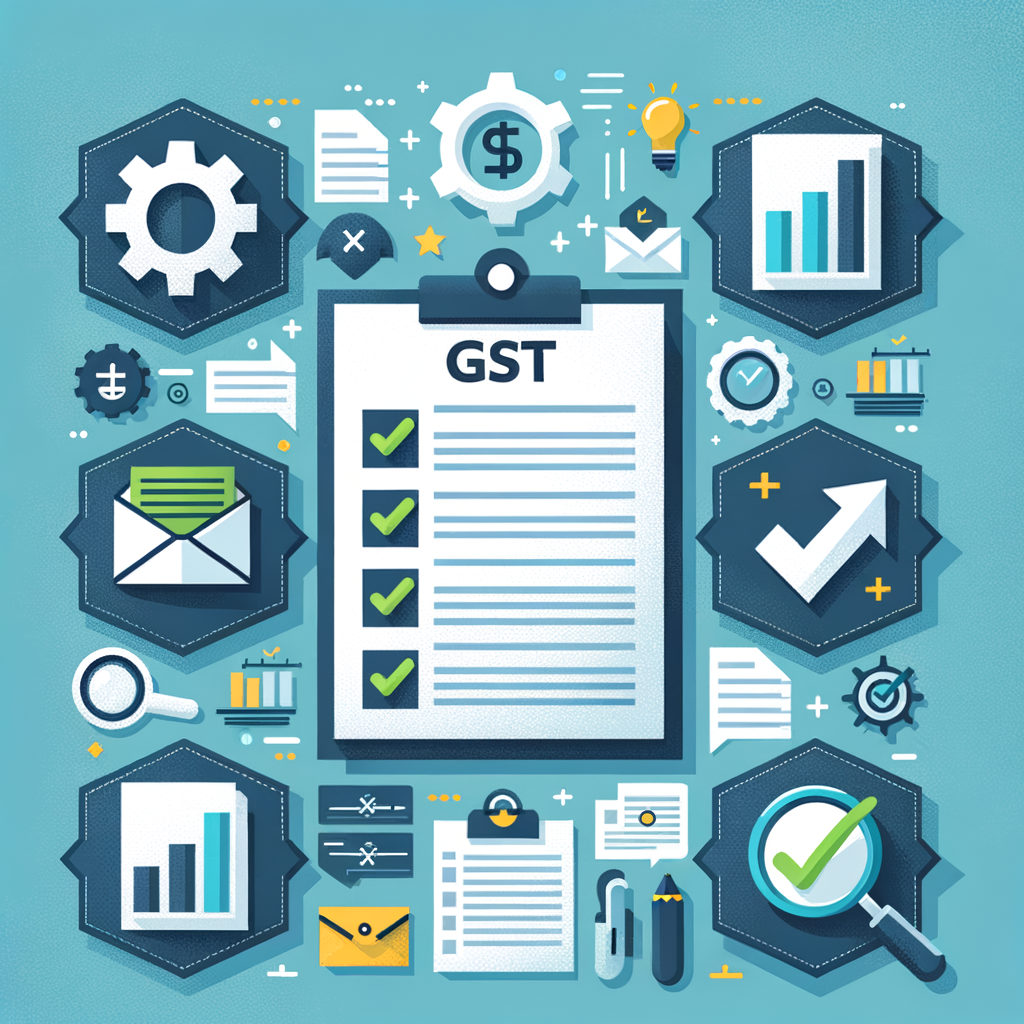How to Create a GST Compliance Checklist for Your Business
Meta Description: A comprehensive guide for Indian businesses on creating a foolproof GST compliance checklist. Learn the essential steps, tips, and common pitfalls to ensure your business stays compliant and avoids penalties.
Navigating the world of Goods and Services Tax (GST) can feel like a daunting task for many small business owners in India. With multiple deadlines, intricate rules, and the constant fear of penalties, managing compliance can be a significant source of stress. Managing these responsibilities without a structured system often leads to missed filing dates, incorrect Input Tax Credit (ITC) claims, and costly notices from the tax department. This is where a simple yet powerful tool comes to the rescue: a GST compliance checklist. Think of it as your business’s roadmap to streamlining tax processes, ensuring complete accuracy, and achieving compliance with confidence. This article provides a practical, step-by-step guide for creating a personalized checklist, making it an invaluable resource in any GST compliance guide for Indian businesses.
Why a GST Compliance Checklist is Non-Negotiable for Indian Businesses
In the fast-paced world of business, it’s easy to get caught up in operations, sales, and growth, pushing compliance to the back burner. However, this reactive approach can be incredibly costly. The true importance of a GST compliance checklist lies in its ability to transform your GST management from a reactive, stressful chore into a proactive, seamless business function. It is not just about ticking boxes; it’s about building a robust framework that safeguards your financial health and enhances your business’s reputation. A well-maintained business compliance checklist for GST is one of the most effective risk mitigation tools you can implement, providing a clear and consistent path to follow every day, month, and year. This systematic approach ensures that no detail is overlooked, from the smallest invoice to the largest annual return.
Adopting a checklist system offers several tangible benefits that directly impact your bottom line and operational efficiency:
- Avoids Penalties and Interest: The most immediate benefit is financial. A checklist acts as a constant, timely reminder for all due dates, helping you steer clear of late fees (which can be up to ₹10,000) and interest charges of 18% per annum on unpaid tax.
- Ensures Timely Filing: By systematically tracking due dates for GSTR-1, GSTR-3B, and other relevant returns, you can eliminate the last-minute rushes and potential errors that come with hurried filings.
- Maximizes Input Tax Credit (ITC): A checklist promotes the crucial habit of monthly reconciliation of purchases with GSTR-2B. This ensures you never miss out on claiming eligible ITC, which directly improves your business’s cash flow.
- Improves Financial Accuracy: A structured process significantly reduces the chances of human error in your record-keeping, tax calculations, and return filing, leading to more reliable financial data.
- Builds Business Credibility: A consistent and clean compliance record improves your GST compliance rating. This makes your business more attractive and reliable in the eyes of vendors, potential lenders, and large corporate clients who often vet a supplier’s compliance history.
Core Components of GST Compliance in India
Before building your checklist, it’s essential to understand the fundamental building blocks of the GST framework. These are the core activities that form the basis of your compliance tasks. Mastering these concepts is the first of many crucial GST compliance steps India requires from every registered business. A solid grasp of these components will not only help you create an effective checklist but also empower you to make more informed financial decisions for your business. From the returns you file to the invoices you issue, each element plays a critical role in the larger compliance puzzle.
Understanding Key GST Returns
For most small businesses, GST compliance revolves around a few key returns. Understanding their purpose is critical.
- GSTR-1: This is your sales return. In GSTR-1, you report the details of all your outward supplies (sales of goods and services) for the tax period. This data is what populates the GSTR-2A/2B for your customers.
- GSTR-3B: This is a monthly summary return. Here, you declare your summarized GST liabilities for the month, claim your eligible Input Tax Credit, and make the final tax payment to the government.
- GSTR-2A/2B: These are auto-drafted statements for your purchases. GSTR-2B, which is static, is the more important of the two. It shows the ITC that is available to you for a particular month based on the GSTR-1 filed by your suppliers. Reconciliation with GSTR-2B is mandatory for claiming ITC.
For more detailed information on different GST returns, you can explore the resources available on the TaxRobo GST Service page.
Essential Concepts: Invoicing, E-way Bills, and ITC
Beyond returns, daily operational compliance hinges on a few key concepts.
- GST Invoicing: A GST-compliant tax invoice is a legal requirement and the primary document for passing on ITC. It must contain mandatory fields such as your GSTIN and the customer’s GSTIN, invoice number and date, HSN/SAC code for goods/services, place of supply, tax rates (CGST, SGST, IGST), and total tax amount. A comprehensive breakdown can be found in our guide on Understanding GST Invoicing: A Detailed Guide.
- E-way Bills: An E-way bill is a document required for the movement of goods worth more than ₹50,000. It must be generated from the official portal before the goods are transported, and it contains details of the goods, the consignor, the recipient, and the transporter. For detailed instructions, see our Guide to GST E-Way Bill Generation.
- Input Tax Credit (ITC): ITC is the heart of the GST system. It means that when you pay tax on your business inputs (purchases), you can deduct that amount from the tax you are liable to pay on your outputs (sales). To claim ITC successfully, you must have a tax invoice, have received the goods/services, and your supplier must have filed their GSTR-1 and paid the tax to the government. Verifying this in your GSTR-2B is non-negotiable.
How to Make a GST Compliance Checklist: A Step-by-Step Breakdown
Now, let’s get to the core of the matter: creating a GST compliance checklist for your business. The most effective approach is to break down tasks by frequency—daily, monthly, quarterly, and annually. This structure ensures that compliance becomes an integrated part of your business routine rather than a periodic crisis. This model is especially useful as a GST checklist for small businesses in India, as it provides clarity and helps in delegating tasks effectively. For new ventures, this can serve as an excellent template to prepare a GST compliance checklist for startups from day one.
Daily Compliance Tasks
These are habits that should be woven into your daily operations to ensure foundational accuracy.
- Issue GST-Compliant Invoices: Ensure every single B2B and B2C invoice you raise is 100% accurate, complete, and issued promptly upon the supply of goods or services. Use accounting software to automate this and reduce errors.
- Generate E-way Bills: For every consignment of goods valued over ₹50,000, generate the E-way bill from the portal before the vehicle leaves your premises. Keep a record of all generated E-way bills.
- Maintain Records: This is the most crucial daily habit. Accurately record all sales, purchases, expenses with GST, and any debit or credit notes issued in your accounting software. This daily discipline makes month-end reconciliation a breeze. The importance of Maintaining Accurate Accounting Records for Tax Purposes cannot be overstated.
Monthly Compliance Tasks
These tasks are time-sensitive and form the core of your filing obligations.
- Sales Reconciliation: Before the 10th of each month, match the sales data in your books of accounts with the sales data you plan to upload in your GSTR-1. This prevents discrepancies.
- Purchase Reconciliation: This is a critical step. Reconcile your purchase register with the auto-populated GSTR-2B report. Identify any missing invoices from suppliers and follow up with them. Finalize the exact amount of ITC you are eligible to claim for the month.
- GSTR-1 Filing: File the details of all your outward supplies for the preceding month in Form GSTR-1 by the 11th of the following month.
- GSTR-3B Filing: Based on your sales and reconciled ITC, file the summary return in Form GSTR-3B and pay the tax liability. The due date is the 20th, 22nd, or 24th of the following month, depending on your state and turnover.
- Reverse Charge Mechanism (RCM) Review: Review your expenses to identify any purchases that fall under RCM (e.g., services from a Goods Transport Agency, legal services from an advocate). You must calculate and pay GST on these yourself and can claim ITC in the next month.
Quarterly Compliance Tasks
These tasks are primarily for businesses that have opted for the QRMP (Quarterly Return Monthly Payment) scheme.
- For QRMP Scheme Filers:
- Pay tax using Form PMT-06 by the 25th of the month following the first two months of the quarter (e.g., by April 25th for the Jan-Mar quarter’s January tax).
- File your quarterly GSTR-1 and GSTR-3B by the relevant due dates (13th for GSTR-1, 22nd/24th for GSTR-3B of the month following the quarter).
- Review and Analysis: Even if you file monthly, take time at the end of each quarter to conduct a high-level review of your tax payments, ITC claims versus availability, and any trends in your GST liability.
Annual Compliance Tasks
These tasks provide a comprehensive overview of your GST activities for the entire financial year.
- Filing Annual Return (GSTR-9): This is a consolidated return of all your monthly/quarterly returns filed during the financial year. You must reconcile the data with your audited (or unaudited) financial statements. The due date is December 31st of the year following the financial year.
- Filing Reconciliation Statement (GSTR-9C): If your annual turnover exceeds ₹5 crore, you must file a self-certified reconciliation statement in Form GSTR-9C. This statement reconciles the turnover and taxes paid as per your books of accounts with the figures reported in GSTR-9.
Essential GST Compliance Checklist Tips for Success
Creating a list is one thing; implementing it successfully is another. Following these practical GST compliance checklist tips will help you transform your checklist from a static document into a dynamic tool that drives efficiency and accuracy in your business. Adhering to these best practices is a hallmark of a robust GST compliance checklist India requires for seamless business operations.
Leverage Technology
Manual compliance is prone to errors and incredibly time-consuming. Using modern accounting software (like Zoho, Tally, or QuickBooks) can be a game-changer. These tools can automate GST-compliant invoicing, generate return formats like GSTR-1 with a single click, and offer features for bank reconciliation and ITC matching. This investment minimizes human error and frees up valuable time to focus on your core business.
Maintain Separate Business Accounts
Mixing personal and business finances is a common mistake that complicates GST compliance immensely. Keep a dedicated bank account and credit card for all business transactions. This creates a clean, auditable trail of income and expenses, making it significantly easier to track transactions, reconcile your books, and prepare for any potential audits by the tax authorities.
Stay Informed
GST laws and regulations are dynamic and subject to frequent amendments and notifications from the GST Council. What is compliant today might change tomorrow. Make it a habit to stay updated. You can do this by subscribing to newsletters from reputable tax consultancies or by regularly checking for updates. For the most authentic information, always bookmark and refer to the official GST portal.
Seek Professional Help When Needed
As a business owner, your primary focus should be on growth and innovation. If GST compliance becomes a bottleneck that consumes too much of your time and energy, it’s a wise decision to seek professional assistance. Partnering with experts like TaxRobo can save you time, prevent costly mistakes, and provide peace of mind. Professionals can manage your filings, ensure you maximize your ITC claims, and offer strategic advice to optimize your tax position. For comprehensive support, consider exploring TaxRobo’s main “GST Filing Services” page.
Conclusion
In the complex landscape of Indian taxation, consistency is the key to successful GST compliance. The daily, monthly, quarterly, and annual tasks might seem extensive, but when broken down and managed systematically, they become routine. A robust GST compliance checklist is the tool that makes this possible. It transforms a daunting set of legal obligations into a manageable and predictable business process. By implementing this checklist, you are not just avoiding penalties; you are safeguarding your company’s financial health, building a reputation for reliability, and creating a solid foundation for sustainable growth.
Feeling overwhelmed by GST? Let TaxRobo’s experts create and manage your GST compliance checklist for you. From filing returns to providing strategic tax advice, we ensure your business remains 100% compliant. Contact us today for a free GST health check-up!
Frequently Asked Questions (FAQs)
Q1. What is the most critical task in a monthly GST compliance checklist for a small business?
A: The most critical task is reconciling your purchase records with GSTR-2B before filing GSTR-3B. This ensures you claim the correct Input Tax Credit (ITC) and avoid potential notices from the tax department for excess claims, which can lead to interest and penalties.
Q2. Do I still need a GST compliance checklist if I am under the QRMP scheme?
A: Yes. While return filing is quarterly, tax payment is still monthly (via Form PMT-06). A checklist is essential to track these monthly payment deadlines and to systematically gather and reconcile data throughout the quarter, ensuring an accurate and stress-free quarterly GSTR-1 and GSTR-3B filing.
Q3. Can I use a simple spreadsheet to prepare a GST compliance checklist for my startup?
A: Absolutely. For a new business, a well-organized spreadsheet is a great and cost-effective starting point to prepare a GST compliance checklist for startups. You can list tasks, assign owners, set reminders for due dates, and track completion status effectively before you scale up to more sophisticated software.
Q4. What are the consequences of missing a GST compliance deadline in India?
A: Missing a GST deadline results in automatic penalties. This includes a per-day late fee for delayed return filing (which varies but is capped) and interest at 18% per annum on the amount of outstanding tax. Continuous non-compliance can lead to more severe actions like GST registration cancellation and blocking of e-way bill generation.
Q5. How can an expert help with my business compliance checklist for GST?
A: An expert like TaxRobo can help you create a customized checklist tailored to your specific industry and business operations. They can automate your filing processes, ensure 100% accuracy in ITC claims through advanced reconciliation tools, and provide timely advice on any changes in GST law, allowing you to focus completely on growing your business without worrying about compliance.



